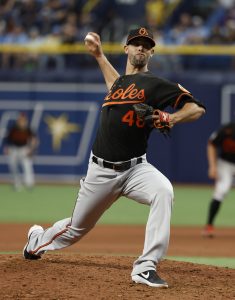Luis Castillo was a Blue Jays trade target last winter, and unsurprisingly, Toronto continues to have interest in Castillo’s services, according to USA Today’s Bob Nightengale. Though Castillo missed the first month of the season due to shoulder soreness, he has been in strong form with a 2.92 ERA over 71 innings, even if his Statcast numbers aren’t quite as reflective of top-notch performance. Castillo’s walk rate and hard-contact numbers are only okay, though his strikeout rate (25.3%) is well above league average and he still has elite fastball velocity.
The Reds right-hander is one of the very best players (let alone pitchers) expected to be available as the deadline approaches, making him a natural fit for a Toronto club in sore need of pitching upgrades. Between Hyun Jin Ryu’s Tommy John surgery and underwhelming performances from Jose Berrios and Yusei Kikuchi, the faulty rotation has been the chief reason for the Jays’ struggles in the last month, which is why Nightengale writes that the Blue Jays “are expected to be the most aggressive team pursuing starting pitching help.” Last summer’s trade for Berrios is an example of how the Toronto front office hasn’t been hesitant to pay a big price for a player they want and need, though the Blue Jays will face plenty of competition for Castillo’s services.
More from both the AL East and NL East…
- Also from Nightengale, the Orioles’ surprisingly strong play seemingly hasn’t changed the club’s long-term plans, as Baltimore is “expected to unload” several notable veterans. The list of names includes both impending free agents like Trey Mancini, Rougned Odor, and Jordan Lyles, plus more controllable players like Anthony Santander and All-Star closer Jorge Lopez. It’s safe to assume that the price tag will be a lot higher for Lopez and Santander than the others, but regardless, the O’s likely aren’t going to change course and start thinking about a playoff push.
- Starling Marte left Saturday’s game due to a groin injury, and Marte wasn’t in the Mets lineup on Sunday. However, Marte is only day-to-day, as manager Buck Showalter told reporters (including MLB.com’s Anthony DiComo) that an MRI revealed only minor inflammation and no serious damage. Marte has been a big contributor in his first year in New York, and his first-half performance earned him a slot on the NL All-Star team earlier today. With this groin injury lingering, however, Marte might opt to skip the game to rest up over the break.
- Kevin Kiermaier was placed on the 10-day injured list earlier today, marking the second time this month that a nagging hip injury has put the Rays outfielder on the shelf. Kiermaier told reporters (including Marc Topkin of the Tampa Bay Times) that he received a cortisone shot during his first IL stint, but now that the issue has returned, he’ll be visiting a specialist to further explore the injury. “There’s just a lot of unknowns right now with what’s to come….I don’t really know what the future holds, to be quite honest,” Kiermaier said, noting that surgery was a possibility. A major procedure could quite possibly end Kiermaier’s season, and thus maybe his tenure with the Rays altogether, as 2022 is the final guaranteed year of his contract. Kiermaier has spent all 13 of his pro seasons in the Tampa organization, though that tenure has involved several injury absences.
- There hasn’t been much public information revealed about the Nationals’ possible sale, but billionaire Michael B. Kim is the first name linked to the list of potential buyers, according to Barry Svrluga and Chelsea Janes of The Washington Post. Kim and another bidding group have met in person with team officials already, and a third group is also slated for in-person meetings later in July. Though there seems to be an increasing feeling that the Lerner family will indeed sell the Nationals, it is still early in the process, since “as many as five or six individuals or groups are expected to meet with club officials.”
